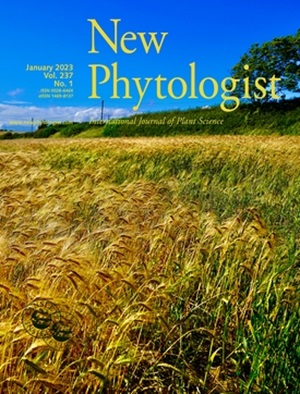Phylogenetic and biochemical drivers of plant species variation in organic compound hydrogen stable isotopes: novel mechanistic constraints
IF 8.3
1区 生物学
Q1 PLANT SCIENCES
引用次数: 0
Abstract
- Significant variation in plant organic compound hydrogen stable isotope (δ2H) values among species from a single location suggests species biochemistry diversity as a key driver. However, the biochemical mechanisms and the biological relevance behind this species-specific δ2H variation remain unclear.
- We analyzed δ2H values of cellulose and n-alkanes across 179 eudicot species in a botanical garden sampled in 2019, and cellulose, n-alkanes, fatty acids and phytol δ2H values from 56 eudicot species sampled in 2020. We utilized the observed species variation in δ2H values to determine phylogenetic structure and mechanistic constraints for biochemical 2H-fractionation.
- A strong phylogenetic signal in lipid compound δ2H values implies that the drivers of species variation in lipid δ2H values are evolutionarily conserved. By contrast, species variation in cellulose δ2H values was not strongly linked to phylogeny. Generally low-explanatory power of relationships between δ2H values of different compounds (R2 < 0.26) implies nonubiquitous drivers of species variation in plant organic compound δ2H values.
- Historically, variable biochemical 2H-fractionation was often attributed to δ2H values of H incorporated from NADPH. Instead, the results from this study suggest that species variation in biochemical 2H-fractionation largely occurs independently within biosynthetic pathways. For lipids, these mechanisms appear strongly linked to evolutionary history.
求助全文
约1分钟内获得全文
求助全文
来源期刊

New Phytologist
生物-植物科学
自引率
5.30%
发文量
728
期刊介绍:
New Phytologist is an international electronic journal published 24 times a year. It is owned by the New Phytologist Foundation, a non-profit-making charitable organization dedicated to promoting plant science. The journal publishes excellent, novel, rigorous, and timely research and scholarship in plant science and its applications. The articles cover topics in five sections: Physiology & Development, Environment, Interaction, Evolution, and Transformative Plant Biotechnology. These sections encompass intracellular processes, global environmental change, and encourage cross-disciplinary approaches. The journal recognizes the use of techniques from molecular and cell biology, functional genomics, modeling, and system-based approaches in plant science. Abstracting and Indexing Information for New Phytologist includes Academic Search, AgBiotech News & Information, Agroforestry Abstracts, Biochemistry & Biophysics Citation Index, Botanical Pesticides, CAB Abstracts®, Environment Index, Global Health, and Plant Breeding Abstracts, and others.
 求助内容:
求助内容: 应助结果提醒方式:
应助结果提醒方式:


